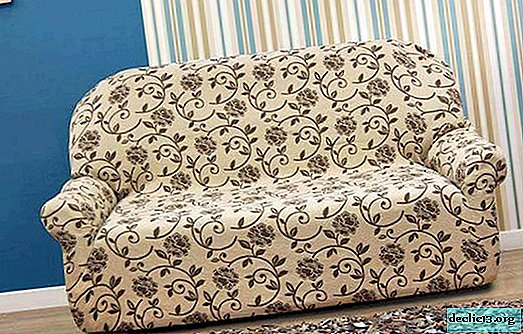Options for pockets for lockers in kindergarten, and how to choose
The kid has grown up and will soon go to kindergarten. It is worth preparing for this moment in advance, taking into account all the nuances, so that he is comfortable in a new place. The kindergarten, like the theater, begins with a hanger, or rather, with a dressing room closet, in which the child begins to fold outerwear. Convenient pockets on a cabinet in a kindergarten can solve the problem of placing things.
Purpose and features
A standard kindergarten locker does not meet the requirements that apply to it. Children need to equip a place for many important little things, in addition, a new environment is always stress for a little man. Even if at home the baby always asks for a pot, the first time in the kindergarten replaceable things may come in handy quite unexpectedly:
- panties;
- socks;
- T-shirt
- T-shirt;
- handkerchief;
- warm sweater;
- tights.
In addition to the shift, you need to provide where the comb will lie, and for girls, also hair clips. It is convenient to store all these accessories with a pocket that will save space in the cabinet, make it easier for staff to find the necessary accessories, and also teach the baby to keep order.
It should be noted that in all kindergartens, physical education classes are mandatory, so the child will have to keep a sports form somewhere. Many gardens have their own pool, but a separate room for bath clothes is not always. So, you should also take care of where the child will place swimming accessories (hat, waterproof glasses, bathrobe, bath accessories).
The dimensions of the cabinet in the kindergarten do not allow you to mount additional shelves for practical placement of everything you need, but there is a solution and there are hinged pockets on the cabinet door.



Varieties
Suspended pockets differ in the way of fastening:
- eyelets or eyelets - they are traditional and most reliable, are fixed on the doors with screws or hung on hooks;
- elastic band - does not require additional fasteners, but sags under the weight of the clothes;
- sticky tape with a bend top, fastens easily, is removed quickly;
- fastenings on double-sided tape are not practical, but they "save" in a situation where it is impossible to screw a nail or screw into the door for some reason.
Pockets on a cabinet in a kindergarten can be with different departments:
- on an elastic band;
- closed valves with Velcro or button;
- open branches;
- with personalized embroidery or applique image of your favorite character.
The existing options for pockets with a foldable top edge on the front of the cabinet are very practical, they are equipped with an inscription with the name of the child, a memorable bright picture, by which the baby can easily find his cabinet among others.
 On sticky tape
On sticky tape Kink top
Kink top Hinged
HingedBy size are allocated:
- giants, on the whole door;
- , medium-sized surfaces;
- small ones.
Preference should be given to large and medium pockets on the doors, they will be relevant throughout the kindergarten life of a small person in any situation. As a child grows up, the number of removable items in his pocket may decrease, but the size of the clothes will increase. Options with a small number of departments do not cope with their function, are extremely inconvenient, can be useful only for a while, until the baby has a full-fledged organizer.
Materials
Suitable material pockets for kindergarten are:
- water-repellent fabric (tarpaulin, raincoat fabric, Bologna);
- any other textiles;
- thin flexible plastic.
Making plastic pockets can be tricky at home, but they are easy to get at specialized stores. They are easier to operate - they are disinfected with the usual tool for processing plastic surfaces, without removing from the cabinet. Sometimes the gardens themselves purchase hinged pockets centrally. With some skills, mom will be able to sew the original organizer to the kindergarten with her own hands to her beloved daughter or son.



How to do it yourself
First you need to come up with an idea, you can look at it in the photo or invent and develop it yourself, carefully calculating all the details and thinking through the design. Homemade has a lot of advantages:
- It is made exactly according to the dimensions of the cabinet;
- it will be possible to sew from the remnants of tissue;
- here you can vary the size, as well as the shape of the pockets;
- it’s interesting to decorate the product, it’s exciting to do it even with a child!
Sometimes kindergarten lockers have a rounded top, in this case we sew the base with this feature in mind. Here you can put an additional compartment under the children's book or other useful trifle. The organizer for the locker in the kindergarten should be easy to wash, safe for children: it is not allowed to decorate your creation with small details (beads, buttons, beads) that kids can swallow.
Necessary materials and tools
To sew a pocket in a cabinet with a door area of 80x30 cm, you will need:
- 1 meter of main fabric;
- 1 meter lining;
- non-woven;
- scissors;
- threads
- sealant for stiffness (plastic, underlay for laminate, foam);
- Velcro or snap fastener
- rubber;
- decorative elements with a children's theme (ribbons, decoration tape, appliqués, embroidery)
The fabric should be easy to wash and dry quickly. Cardboard for stiffness of the pocket is better not to use, it is short-lived, has the property of deforming during washing.
The organizer will not work out in half when all the pockets are full, if you insert 1-1.5 cm thick bamboo sticks from above and below. For this, we sew a drawstring or eyelets from the back of the base. The sticks should be easily removable, because the product will have to be washed often! If plastic is used for stiffness, additional fixation with chopsticks is not required, but you need to provide the opportunity to get it before washing, for example, provide the base with a zipper.

Cutting products
From the selected fabric, 2 parts of the base 80x30 cm are cut out, and several pockets: two 40 cm each for a sports uniform and replaceable clothes, and one or several additional ones for other accessories. If the size of the cabinet allows, and the baby has not yet learned how to completely control himself and sometimes wet his pants, another pocket will be useful - for used clothes that must be taken home from the garden. All details of the pocket, except for the base, are duplicated on the lining fabric and non-woven.
One pocket, for example, the upper one, is made of mesh. This will make it easier for the little man, without looking into each pocket to find a comb or handkerchief. Do not forget to add allowances for the seams: 1 cm on the sides and 2 - on the upper side of the pocket - to insert the elastic.
 We cut the material into 3 parts 33x38 cm
We cut the material into 3 parts 33x38 cmBranch Processing
If desired, pockets are decorated with embroidery or appliqués are glued with your favorite fairy-tale characters. This is best done before the part is sewn to the base of the pocket. Next, the corresponding parts of the main fabric, non-woven fabric and pad are combined and stitched together with an estimated seam. They tuck the top of the pocket compartment inwards and stitch it - a rubber band is inserted here and fixed at the edges, after having pulled the workpiece up to 30 cm.The bottom edge of the pocket is laid in deep folds on both sides, they are necessary to create volume and to remove excess width. Pockets can be closed with valves, which are cut out separately in the form of a trapezoid or a triangle. Velcro is used as a fastener - it is completely safe for kids.
 Fold the parts in half
Fold the parts in half Sew on the long side, departing from the edge of 1 cm
Sew on the long side, departing from the edge of 1 cm We turn the parts and stitch sideways to the bend
We turn the parts and stitch sideways to the bend Having departed from the edges by 0.5 cm, we lay the folds 2 cm deep, iron
Having departed from the edges by 0.5 cm, we lay the folds 2 cm deep, iron Pockets are formed
Pockets are formedAssembly order
The bottom of the pocket is sewn to the base with a hidden seam. It is turned over, and sidewalls are sewn. Repeat this for all other pockets, slightly departing from each other. An additional vertical line is laid along the upper compartment, indicating the compartment under the comb. When all the pockets are ready, the main parts are stitched, folding with the front sides to each other. The underside is left unstitched. The product is turned out, a seal is inserted between the base parts to stiffen the pocket and the remaining edge is healed. Pockets around the perimeter can be trimmed with original lace with a children's theme, and around the edges with the help of an awl, pierce holes for grommets or make loops from the same material as the product itself. The child will surely enjoy decorating the pocket with fabric self-adhesive stickers with images of his favorite fairy-tale characters, do not refuse to help him in the pleasure! The hanging organizer is ready, it remains to hang it in the locker for baby clothes, securing it to the door with screws.
The kid will be able to be proud of the pocket that her mother sewed and decorated with it! A quality thing is useful to the child even after the kindergarten is left behind. The pocket is sure to find a place in the nursery, bathroom or hallway.
 We lay out the details on a felt basis and sew
We lay out the details on a felt basis and sew Stitched pocket
Stitched pocket We put the binding on the felt face down, pin it off with pins or bast
We put the binding on the felt face down, pin it off with pins or bast We turn the tape on the wrong side of the base, turn it and hem
We turn the tape on the wrong side of the base, turn it and hem Install the grommets in the upper corners. Tie the cord
Install the grommets in the upper corners. Tie the cord Velcro for pockets
Velcro for pockets Finished pocket
Finished pocketVideo
Photo























